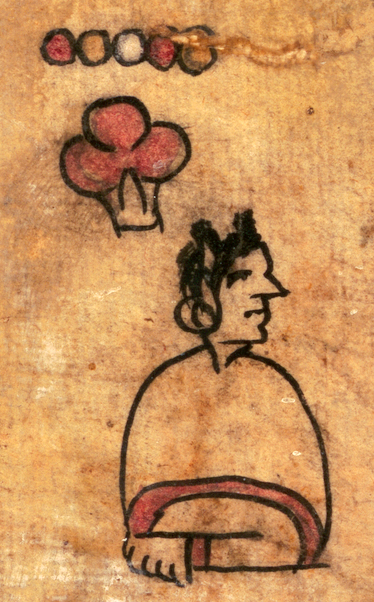Macuilli Xochitl (CQ)
This combined simplex glyph with a notation is a personal name Five Flower, Macuilli Xochitl, which is a day sign in the calendar. The notation involves five ones, all of them small circles in a horizontal row. They are colored variously, but perhaps in a pattern--red, yellow, white, and starting again. The flower has three obvious petals, painted red, and its base is white.
Stephanie Wood
Five Flower was married to Chicome Mazatl, also known as don Felipe Pascual, a tlahtoani of Tecamachalco in the 1560s, according to a study of the manuscript by Sebastián van Doesburg (see our Bibliography). Don Felipe is spoken of as deceased in the manuscript, which tells us that the text associated with his image is later than the end of his rule (1568). Five Flower, who was also an important person in the Anales de Tecamachalco, may have been the sister of don Pedro de León, according to van Doesburg. The annals mention her death as having taken place in 1567.
For comparative purposes, appearing below are some variations on flowers and fives from other codices.
Stephanie Wood
covers ruling men and women of Tecamachalco through 1593
five, cinco, flowers, flores, numbers, números, names, nombres, dates, fechas

macuil(li), five, https:nahuatl.wired-humanities.org/content/macuilli
xochi(tl), flower, https:nahuatl.wired-humanities.org/content/xochitl
tonalpohual(li), 260-day calendar, https:nahuatl.wired-humanities.org/content/tonalpohualli
Cinco Flor, 5-Flor
The Codex Quetzalecatzin, aka Mapa de Ecatepec-Huitziltepec, Codex Ehecatepec-Huitziltepec, or Charles Ratton Codex. Library of Congress. https://www.loc.gov/item/2017590521/
The Library of Congress, current custodian of this pictorial Mexican manuscript, hosts a digital version online. It is not copyright protected.





